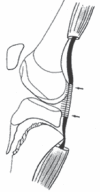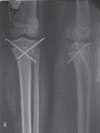Proximal Tibial Epiphysis Injury (Flexion Type, Salter-Harris Type 1)
- PMID: 28164055
- PMCID: PMC5288628
- DOI: 10.13107/jocr.2250-0685.572
Proximal Tibial Epiphysis Injury (Flexion Type, Salter-Harris Type 1)
Abstract
Introduction: Fractures of the proximal tibial epiphysis rare. It has been estimated that fractures of the upper tibial epiphysis account for 0.5-3.1% of all epiphyseal injuries. Who had no neurovascular deficit, with fixed extension deformity at the left knee was treated early with closed reduction techniques.
Case report: We present a case of a 16-year-old boy who while playing cricket on the road was hit by a car. The patient presented in emergency room with extremely swollen knee and soft tissue swelling (hemarthrosis), he was unable to lift his leg actively due to severe pain because of hamstrings spasm, and he had no wound over his left knee and had no other associated injuries. Plain radiographs were taken which revealed, separated proximal tibial epiphysis (salter harris Type 1 injury) The epiphysis was anteriorly displaced fracture line extending beyond growth plate through metaphysis and tibial tuberosity also displaced anteriorly, the proximal fibular epiphysis fragment was displaced anteriorly with no injury to femoral epiphysis and no patellar fracture, radiograph also revealed no intra-articular fracture as joint appears congruent. Under spinal anesthesia, under all aseptic precautions traction was applied for few minutes, the fracture was reduced closed as the hamstring spasm gave way, reduction was confirmed under image intensifier in both AP and lateral planes, and joint congruity was examined. Proximal fibular epiphysis also snapped back in place. Post-operative patient was immobilized with nil weight bearing for 4 weeks, check X-rays taken, he was mobilized in wheelchair. After 4 weeks slab was removed, K-wires were removed, and partial weight bearing was started with rehabilitation for full range of motion of the left knee. At 6 weeks, both the knee joints appeared symmetrical with no abnormalities or limb length discrepancy or instability with knee from 0° to 140°, with full weight bearing.
Conclusion: Although less commonly seen, Salter-Harris Type 1 injuries to proximal tibial physis, if managed early with closed reduction and fixation, excellent long-term results can be achieved.
Keywords: Proximal tibial epiphysis; adolescent injury; salter harris type 1.
Conflict of interest statement
Conflict of Interest: Nil
Figures
Similar articles
-
Salter-Harris Type 2 Injury of the Proximal Tibial Epiphysis in a 15-year-old Athlete: A Rare Case Report.J Orthop Case Rep. 2021 Nov;11(11):95-98. doi: 10.13107/jocr.2021.v11.i11.2532. J Orthop Case Rep. 2021. PMID: 35415107 Free PMC article.
-
Open Reduction and Internal Screw Fixation of Transitional Ankle Fractures in Adolescents.JBJS Essent Surg Tech. 2021 Dec 22;11(4):e19.00070. doi: 10.2106/JBJS.ST.19.00070. eCollection 2021 Oct-Dec. JBJS Essent Surg Tech. 2021. PMID: 35685651 Free PMC article.
-
Screw Fixation of Pediatric Tibial Tubercle Fractures.JBJS Essent Surg Tech. 2021 Jun 10;11(2):e19.00062. doi: 10.2106/JBJS.ST.19.00062. eCollection 2021 Apr-Jun. JBJS Essent Surg Tech. 2021. PMID: 34277133 Free PMC article.
-
Operative treatment of fractures about the knee.Orthop Clin North Am. 1990 Apr;21(2):365-79. Orthop Clin North Am. 1990. PMID: 2183135 Review.
-
Bilateral atraumatic tibial tubercle avulsion fractures: case report and review of the literature.Injury. 2015 Apr;46(4):767-9. doi: 10.1016/j.injury.2015.01.012. Epub 2015 Jan 16. Injury. 2015. PMID: 25638599 Review.
Cited by
-
Proximal Tibial Epiphysis Fracture in a 13-Year-Old Male Athlete.Case Rep Orthop. 2017;2017:4823589. doi: 10.1155/2017/4823589. Epub 2017 May 21. Case Rep Orthop. 2017. PMID: 28607786 Free PMC article.
-
Salter-Harris Type 2 Injury of the Proximal Tibial Epiphysis in a 15-year-old Athlete: A Rare Case Report.J Orthop Case Rep. 2021 Nov;11(11):95-98. doi: 10.13107/jocr.2021.v11.i11.2532. J Orthop Case Rep. 2021. PMID: 35415107 Free PMC article.
References
-
- Peterson CA, Peterson HA. Analysis of the incidence of injuries to the epiphyseal growth plate. J Trauma. 1972;12(4):275–281. - PubMed
-
- Burkhart SS, Peterson HA. Fractures of the proximal tibial epiphysis. J Bone Joint Surg Am. 1979;61(7):996–1002. - PubMed
-
- Poulsen TD, Skak SV, Jensen TT. Epiphyseal fractures of the proximal tibia. Injury. 1989;20(2):111–113. - PubMed
-
- Rhemrev SJ, Sleeboom C, Ekkelkamp S. Epiphyseal fractures of the proximal tibia. Injury. 2000;31(3):131–134. - PubMed
Publication types
LinkOut - more resources
Full Text Sources






